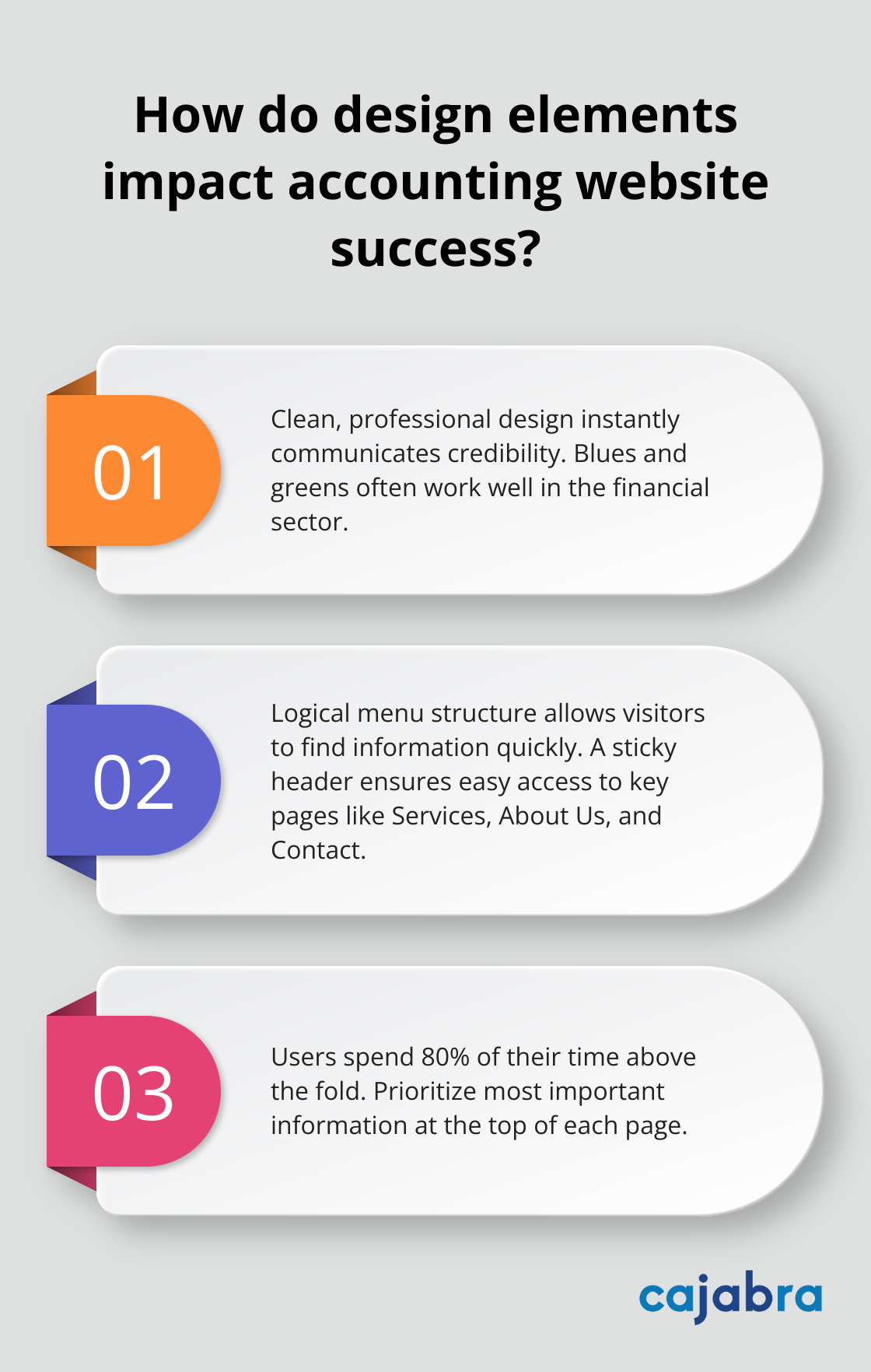
At Cajabra, LLC, we know that a well-designed website is essential for accounting firms to attract and retain clients in today's digital landscape.
Effective accounting websites design goes beyond aesthetics; it's about creating a powerful online presence that showcases your expertise and converts visitors into clients.
In this post, we'll explore the key elements of successful accounting websites and provide practical tips to optimize your online platform for both search engines and user experience.
A successful accounting website serves as a powerful tool to attract new clients, showcase expertise, and differentiate your firm from competitors. Several key elements contribute to an effective accounting website.
First impressions matter, especially in the accounting world. A clean, professional design instantly communicates credibility and attention to detail. Choose a color scheme that aligns with your brand and conveys trust – blues and greens often work well in the financial sector. Use high-quality images (preferably custom photography of your team and office) to add a personal touch.
Your website should mirror the organization of your financial statements. Implement a logical menu structure that allows visitors to find information quickly. Use a sticky header that remains visible as users scroll, ensuring easy access to key pages like Services, About Us, and Contact. A study by the Nielsen Norman Group found that users spend 80% of their time above the fold, so prioritize your most important information at the top of each page.
Showcase your services and expertise prominently. Create dedicated pages for each service you offer, providing detailed information and the benefits clients can expect. Include case studies that demonstrate real-world results (e.g., how you helped a small business save $50,000 in taxes through strategic planning). These concrete examples prove more compelling than generic service descriptions.

Highlight any industry-specific certifications or awards your firm has received. This builds credibility and sets you apart from competitors who may lack these accolades.
Client testimonials and case studies build trust effectively. BrightLocal's Local Consumer Review Survey revealed that 87% of consumers read online reviews for local businesses in 2020. Feature testimonials prominently on your homepage and create a dedicated testimonials page. Include the client's name, photo, and company (with permission) to add authenticity.
Every page on your website should guide visitors towards taking action. Use clear, compelling calls-to-action (CTAs) that stand out visually and use action-oriented language. For example, replace a generic "Contact Us" button with "Schedule Your Free Tax Consultation." Place CTAs strategically throughout your site, especially after sections that highlight your expertise or client success stories.
These elements form the foundation of a powerful online presence for accounting firms. However, a great website doesn't stop at design and content. The next chapter will explore how to optimize your site for search engines and user experience, ensuring that potential clients not only find your website but also have a seamless experience once they arrive.
At Cajabra, LLC, we understand that creating a great website is only half the battle. To truly succeed online, your accounting firm's website needs to be discoverable by potential clients and provide an exceptional user experience. Here's how to achieve both:
Start by identifying the specific terms your ideal clients use when searching for accounting services. Tools like Google Keyword Planner or SEMrush can reveal valuable insights. For example, "small business tax preparation [your city]" might be a high-value, low-competition keyword for your firm.

Once you've identified your target keywords, strategically incorporate them into your website's content, meta descriptions, and page titles. However, avoid keyword stuffing – search engines penalize this practice. Instead, focus on creating natural, informative content that addresses your clients' needs.
Over 60% of web traffic now comes from mobile devices, according to Statista. Your accounting website must be mobile-responsive. This means your site automatically adjusts its layout and functionality to provide an optimal viewing experience across all devices (from smartphones to desktop computers).
Google's mobile-first indexing policy means that the mobile version of your website is now the primary version considered for ranking. Ensure your mobile site loads quickly, has easy-to-tap buttons, and presents information in a clear, concise manner.
Page load speed is essential for both user experience and search engine rankings. According to Google, 53% of mobile site visits are abandoned if pages take longer than 3 seconds to load. To improve your site's speed:
Tools like Google's PageSpeed Insights can help you identify specific areas for improvement on your site.
High-quality, relevant content is the cornerstone of both SEO and user engagement. Create in-depth articles, blog posts, and resources that address your clients' most pressing financial questions and concerns. For instance, a comprehensive guide on "Tax Deductions for Small Business Owners" can attract potential clients while showcasing your expertise.
Update your content regularly to stay relevant and signal to search engines that your site is active. Consider creating a content calendar to ensure consistent publishing of fresh, valuable information.
For most accounting firms, local clients are the lifeblood of the business. Optimize your website for local search by:
According to recent statistics, 29% of business is conducted online. A strong local SEO strategy ensures your firm appears when potential clients in your area are searching for accounting services.
These strategies will help your accounting firm's website rank higher in search results and provide a superior experience for potential clients. The next chapter will explore how to convert these website visitors into actual clients for your accounting practice.
We implement strategically placed lead capture forms throughout your website. Research shows that eliminating just one field can increase conversions by a whopping 50%. We keep your forms short, asking only for essential information like name, email, and specific accounting needs.

We place these forms at key points in the user journey. For example, after a visitor reads a detailed blog post about tax planning, we offer a free consultation form to capitalize on their interest. HubSpot reports that personalized calls-to-action convert 202% better than generic ones, so we tailor your form's language to the specific content the user has engaged with.
We implement an AI-powered chatbot to provide instant support to website visitors. According to Drift, 55% of businesses that use chatbots generate more high-quality leads. We program your chatbot to answer common questions about your services, pricing, and availability. This immediate response can make the difference between a potential client reaching out or moving on to a competitor.
We ensure your chatbot can seamlessly transfer complex inquiries to a human team member when necessary. This combination of automation and personal touch creates a responsive, client-focused experience that can significantly boost conversion rates.
We create downloadable resources that provide immediate value to potential clients. This could include tax preparation checklists, financial planning guides, or industry-specific accounting tips. A Content Marketing Institute study found that 95% of B2B buyers view content as trustworthy when evaluating a company.
We gate these high-value resources behind a simple email sign-up form. This approach not only provides value to the potential client but also allows you to capture their contact information for future marketing efforts. We follow up with automated email sequences that offer additional insights and gently guide the prospect towards scheduling a consultation.
We focus on creating a user-friendly website design that guides visitors towards taking action. This includes clear navigation, prominent calls-to-action (CTAs), and strategically placed contact information. We use contrasting colors for CTAs to make them stand out and employ persuasive copy that emphasizes the benefits of your services.
We also implement A/B testing to continuously improve your website's conversion rate. This involves creating two versions of a webpage (with slight variations) and analyzing which one performs better in terms of conversions. Over time, this data-driven approach leads to significant improvements in your website's ability to turn visitors into clients.
We showcase client testimonials, case studies, and industry awards prominently on your website. This social proof builds trust and credibility with potential clients. We include specific results and metrics in these testimonials (e.g., "Helped us save $50,000 in taxes last year") to make them more impactful.
A well-designed website serves as a powerful tool for accounting firms in the digital age. Professional design, user-friendly navigation, and strategic content showcase expertise and build trust with potential clients. Effective accounting website design combines these elements with search engine optimization and user experience enhancements to attract and convert visitors.

We at Cajabra, LLC help accounting firms create websites that drive real business results. Our JAB System™ moves accountants from overlooked to overbooked in 90 days, securing retainer-based clients and maximizing revenue from existing relationships. This system incorporates the strategies discussed in this post, including lead capture forms, AI-powered chatbots, and valuable downloadable resources.
Your website often provides the first impression of your firm to potential clients. Implementing these strategies will create a powerful online presence that sets your accounting firm apart from competitors and consistently attracts high-quality clients. Take action today to transform your website into a client-generating machine.



